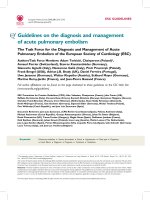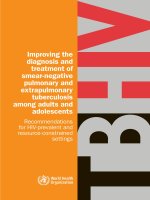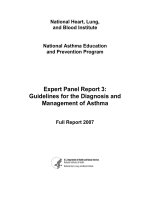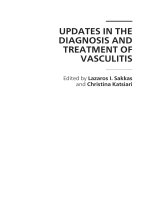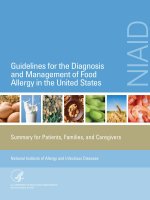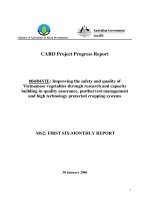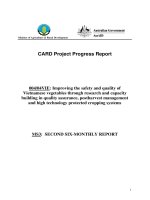Improving the diagnosis and treatment of smear-negative pulmonary and extrapulmonary tuberculosis among adults and adolescents pdf
Bạn đang xem bản rút gọn của tài liệu. Xem và tải ngay bản đầy đủ của tài liệu tại đây (384.24 KB, 44 trang )
Improving the
diagnosis and
treatment of
smear-negative
pulmonary and
extrapulmonary
tuberculosis
among adults and
adolescents
Recommendations
for HIV-prevalent and
resource-constrained
settings
Improving the
diagnosis and treatment of
smear-negative pulmonary and
extrapulmonary tuberculosis
among adults and
adolescents
Recommendations for HIV-prevalent and
resource-constrained settings
STOP TB DEPARTMENT
DEPARTMENT OF HIV/AIDS
© World Health Organization 2006
All rights reserved. Publications of the World Health Organization can be obtained from WHO Press, World Health Organization,
20 Avenue Appia, 1211 Geneva 27, Switzerland (tel.: +41 22 791 3264; fax: +41 22 791 4857; e-mail: ). Requests
for permission to reproduce or translate WHO publications – whether for sale or for noncommercial distribution – should be
addressed to WHO Press, at the above address (fax: +41 22 791 4806; e-mail: ).
The designations employed and the presentation of the material in this publication do not imply the expression of any opinion
whatsoever on the part of the World Health Organization concerning the legal status of any country, territory, city or area or of its
authorities, or concerning the delimitation of its frontiers or boundaries. Dotted lines on maps represent approximate border lines
for which there may not yet be full agreement.
The mention of specific companies or of certain manufacturers’ products does not imply that they are endorsed or recommended by
the World Health Organization in preference to others of a similar nature that are not mentioned. Errors and omissions excepted,
the names of proprietary products are distinguished by initial capital letters.
All reasonable precautions have been taken by the World Health Organization to verify the information contained in this publica-
tion. However, the published material is being distributed without warranty of any kind, either expressed or implied. The respon-
sibility for the interpretation and use of the material lies with the reader. In no event shall the World Health Organization be liable
for damages arising from its use.
The named authors alone are responsible for the views expressed in this publication.
Contents
Acknowledgements iv
Abbreviations v
Part I. Improving the diagnosis and treatment of smear-negative tuberculosis 1
Background 3
Target audience 3
Process of formulation 3
Strength of the recommendations 4
Implementation and evaluation 4
Recommendations 5
Algorithms for the diagnosis of smear-negative tuberculosis 8
Part II. Simplified and standardized clinical management guidelines for
extrapulmonary tuberculosis 15
Background 17
Target audience 17
Diagnosis and management 17
Further reading 23
References 24
Annex. Protocol for operational evaluation of the revised recommendations
and algorithms for improving the diagnosis of tuberculosis in
HIV-prevalent settings 27
Background 29
Objectives of the evaluation 29
Purpose of the protocol 29
Hypotheses 30
Study design and procedure 30
References 36
iii
Prepared by
Members of the WHO Expert Group on Smear-
Negative TB: Getachew Aderaye (Addis Ababa
University, Ethiopia), Ludwig Apers (Institute of
Tropical Medicine, Antwerp, Belgium), Leopold
Blanc (World Health Organization, Switzer-
land), Amy Bloom (United States Agency for
International Development, United States of
America), Jermiah Chakaya (Ministry of Health,
Kenya), Liz Corbett (London School of Tropi-
cal Medicine and Hygiene, United Kingdom),
Haileyesus Getahun (World Health Organiza-
tion, Switzerland), Charlie Gilks (World Health
Organization, Switzerland), Jeroen van Gorkom
(KNCV Tuberculosis Foundation, the Nether-
lands), Mark Harrington (Treatment Action
Group, United States of America), Pierre-Yves
Norval (World Health Organization, Switzer-
land), Paul Nunn (World Health Organization,
Switzerland), Rick O’Brien (Foundation for
Innovative and New Diagnostics, Switzerland),
T. Santha (Ministry of Health, India) and Jay
Varma (United States Centers for Disease Con-
trol and Prevention, Thailand).
Acknowledgements
Useful and detailed feedback was obtained on
an earlier version of the document from more
than 130 national tuberculosis and HIV pro-
gramme managers, WHO regional and country
staff, researchers, clinicians, nongovernmental
organizations and other health workers from all
regions through global web-based consultations.
All leading international organizations work-
ing on tuberculosis, including the International
Union Against Tuberculosis and Lung Disease
(UNION), the Programme Advisory Group for
Acknowledgements
TB (PAG) of KNCV, the German Leprosy and
TB Relief Association and the Damien Founda-
tion have also provided their comments on the
earlier version. The document was reviewed by
members of the Core Group of the global TB/
HIV Working Group of the Stop TB Partnership
and the Strategic and Technical Advisory Group
for Tuberculosis (STAG-TB) and the Strategic
and Technical Advisory Committee for HIV
(STAC-HIV) of the World Health Organiza-
tion.
Valuable comments were also provided by the
following individuals: Raimond Armengol (Pan
American Health Organization), Ramzi Asfour
(WHO Headquarters), Daniel Chin (WHO,
China), Mirtha Del Granado (Pan American
Health Organization), Reuben Granich (Office
of the Global AIDS Coordinator, United States
of America), Christy Hanson (USAID, United
States of America), Michael Kimerling (Uni-
versity of Alabama, United States of America),
Nani Nair (WHO Regional Office for South-East
Asia), Lisa Nelson (Centers for Disease Control,
United States of America), Wilfred Nkhoma
(WHO Regional Office for Africa), Pilar Ramon-
Pardo (Pan American Health Organization),
Mario Raviglione (WHO Headquarters), Fabio
Scano (WHO Headquarters), Akhiro Seita
(WHO Regional Office for the Eastern Mediter-
ranean), Sahu Suvanand (WHO, India), Patrick
van der Stuyft (Institute of Tropical Medicine,
Belgium), Marco Vitoria (WHO Headquarters),
Fraser Wares (WHO, India).
Overall coordination
Haileyesus Getahun.
iv
Abbreviations
AFB acid-fast bacillus
CPT co-trimoxazole preventive therapy
CXR chest X-ray
ETB extrapulmonary tuberculosis
HIV human immunodeficiency virus
IRIS immune reconstitution inflammatory syndrome
PCP Pneumocystis carinii pneumonia
WHO World Health Organization
v
PART I
Improving the diagnosis
and treatment of smear-
negative tuberculosis
3
Background
Rates of smear-negative pulmonary and
extrapulmonary tuberculosis have been rising
in countries with HIV epidemics. The mortality
rate among HIV-infected tuberculosis patients
is higher than that of noninfected tuberculosis
patients, particularly for those with smear-neg-
ative pulmonary and extrapulmonary tubercu-
losis. Delayed diagnosis may be an important
cause of excess mortality in people living with
HIV who have smear-negative pulmonary and
extrapulmonary tuberculosis. In the absence
of rapid, simple, and accurate diagnostic tools
for smear-negative pulmonary and extrapul-
monary tuberculosis, diagnostic algorithms
have been recommended. Earlier algorithms
and recommendations have been developed
through consensus and expert opinion, without
a firm evidence base. These algorithms extend a
patient’s evaluation over a period of time, dur-
ing which HIV-infected patients may die from
undiagnosed tuberculosis or from advanced
HIV complications. The Stop TB Strategy now
emphasizes the timely diagnosis and treatment
of all cases of tuberculosis, including smear-
negative pulmonary and extrapulmonary tuber-
culosis.
The existing guidelines for diagnosis of smear-
negative pulmonary tuberculosis were published
by WHO in 2003 (1) and codified in 2006 in
the International standards for tuberculosis care
(2), a publication of organizations, including
WHO, which are members of the Stop TB Part
-
nership. The International standards generally
maintained the 2003 WHO recommendations,
but recognize the importance of “flexibil-
ity” when applying these guidelines to smear-
negative patients who are seriously ill, such as
patients with HIV infection. It also highlights
the absence of evidence showing how well these
guidelines perform in HIV-infected patients.
Target audience
This document is intended for those deal-
ing with tuberculosis and HIV at all levels in
HIV-prevalent and resource-constrained set-
tings. It is intended to assist development of
national policies to improve the diagnosis and
management of smear-negative pulmonary
and extrapulmonary tuberculosis. The recom-
mendations and algorithms are designed for
use by national tuberculosis and HIV/AIDS
control programmes and service providers.
HIV-prevalent settings are defined as countries,
subnational administration units (e.g. districts,
counties) or selected facilities (e.g. referral hos-
pitals, drug rehabilitation centres) where the
adult HIV prevalence rate among pregnant
women is ≥1% or HIV prevalence among tuber-
culosis patients is ≥5%. In those countries where
national HIV prevalence is below 1%, national
tuberculosis and HIV control authorities should
identify and define HIV-prevalent settings (sub-
national administrative units or facilities) based
on the epidemiology of the HIV epidemic and
the magnitude of HIV-associated tuberculo-
sis, and develop appropriate guidance for the
implementation of these recommendations.
The recommendations and revised algorithms
are intended for immediate implementation in
sub-Saharan Africa and other HIV-prevalent
settings, as defined by national tuberculosis and
HIV control authorities, to guide the expedited
diagnosis and management of tuberculosis.
Process of formulation
In September 2005, WHO convened an expert
group to review currently recommended
approaches to the diagnosis of smear-negative
tuberculosis in HIV-prevalent settings and to
propose revisions to existing WHO guidelines.
The Expert Group has reviewed existing evi-
dence in each of the relevant areas and made
recommendations and has revised the existing
diagnostic algorithms. The recommendations
and revised diagnostic algorithms were then
posted on the WHO Stop TB Department’s
web site for an open consultation. Feedback was
obtained from national programme managers,
researchers, clinicians and other health workers
throughout the world, and from all the leading
international organizations working on tuber-
culosis. The Expert Group subsequently revised
the recommendations and algorithms in the
light of the feedback from the global consultation
and from presentations at various international
scientific meetings. The Strategic and Technical
PART I. IMPROVING THE DIAGNOSIS AND TREATMENT OF SMEAR-NEGATIVE TUBERCULOSIS
4
RECOMMENDATIONS FOR HIV-PREVALENT AND RESOURCE-CONSTRAINED SETTINGS
Advisory Group for Tuberculosis (STAG-TB)
and the Strategic and Advisory Committee for
HIV (STAC-HIV), the two independent bod-
ies that advise WHO on tuberculosis and HIV
respectively, endorsed the recommendations.
Strength of the recommendations
The recommendations contained in these guide-
lines are based on evidence from randomized
clinical trials, high-quality scientific studies,
observational cohort data and, where sufficient
evidence is not available, on expert opinion (see
Table 1). When appropriate, the level of evi
-
dence used to formulate the recommendations is
included in the text of the document and shown
in Table 1. The strength of each recommenda
-
tion is stated when appropriate, along with the
level of evidence, to provide a general indica-
tion of the extent to which regional and country
programmes should consider implementing the
recommendations.
For example, a recommendation marked as A II
is a recommendation that should be followed
and is based on evidence from at least one high-
quality study or several adequate studies with
clinical, laboratory or programmatic endpoints.
Those recommendations which are based on
well established clinical practice are presented as
such, without any indication of the level of evi-
dence. For example, the recommendation that
calls for an increased level of clinical awareness
and competence in managing extrapulmonary
tuberculosis at first-level health facilities is not
linked with a particular level of evidence. The
recommendations do not explicitly consider
Table 1. Grading of recommendations and levels of evidence
Strength of the recommendations Level of evidence available for the recommendations
A. Recommended – should be followed I. At least one randomized controlled trial with clinical,
laboratory or programmatic endpoints
B. Consider – applicable in most situations II. At least one high-quality study or several adequate
studies with clinical, laboratory or programmatic
endpoints
C. Optional III. Observational cohort data, one or more case-controlled
or analytical studies adequately conducted
IV. Expert opinion based on evaluation of other evidence
Sources: adapted from (3), (4), (5), (6).
cost-effectiveness, although the realities of bur-
den of disease, human resources, health system
infrastructure and socioeconomic issues need
to be taken into account when adapting these
recommendations to regional and country pro-
grammes.
Implementation and evaluation
In the absence of complete evidence, the rec-
ommendations were built on consensus and
iterative global expert opinion. It is believed
that they will provide a reasonable response to
the catastrophe posed by the dual tuberculosis
and HIV epidemics. These recommendations
should, therefore, be implemented in HIV-prev-
alent settings in order to improve and expedite
the diagnosis of tuberculosis among people liv-
ing with HIV. The implementation of the rec-
ommendations requires a reasonably efficient
health system, including quality assurance for
laboratories and effective supply management
and training for programme staff. Moreover,
depending on country-specific-factors, it may
require revision of national guidelines, logistical
and technical arrangements including human
resources, training and infrastructure develop-
ment. While the recommendations are being
implemented, it is essential to build up the evi-
dence base required to assess their effectiveness
and feasibility. Careful evaluations by national
authorities, research groups and interested par-
ties are needed to assess the likely benefits and
responsiveness of the recommendations for
the dual tuberculosis and HIV epidemics. The
findings of these evaluations will inform policy
5
change designed to improve programme per-
formance both globally and nationally. A proto-
col that provides generic guidance on evaluation
of the recommendations to improve the diagno-
sis of tuberculosis in HIV-prevalent settings is
annexed to this document.
Recommendations
Revised case definitions
The following are suggested case definitions for
use in HIV-prevalent settings:
Smear-positive pulmonary tuberculosis
• One sputum smear examination positive for
acid-fast bacilli (AFB) and
• Laboratory confirmation of HIV infection or
• Strong clinical evidence of HIV infection.
1
Smear-negative pulmonary tuberculosis
• At least two sputum specimens negative for
AFB and
• Radiographical abnormalities consistent with
active tuberculosis and
• Laboratory confirmation of HIV infection or
• Strong clinical evidence of HIV infection
1
and
• Decision by a clinician to treat with a full
course of antituberculosis chemotherapy
OR
• A patient with AFB smear-negative sputum
which is culture-positive for Mycobacterium
tuberculosis.
Extrapulmonary tuberculosis
• One specimen from an extrapulmonary site
culture-positive for Mycobacterium tubercu-
losis or smear-positive for AFB
OR
• Histological or strong clinical evidence con-
sistent with active extrapulmonary tubercu-
losis and
• Laboratory confirmation of HIV infection or
• Strong clinical evidence of HIV infection
1
and
• A decision by a clinician to treat with a full
course of antituberculosis chemotherapy.
Strength of recommendation: A
Antibiotics trial
Context: There is limited evidence for the use
of empirical antibiotic treatment to rule out
tuberculosis as a cause of cough in HIV-infected
persons. Although non-response to antibiot-
ics increases the likelihood of tuberculosis, the
converse is not true; response to antibiotics does
not exclude tuberculosis in tuberculosis suspects
living in HIV-prevalent settings. Inappropriate
use of broad-spectrum antibiotics may also lead
to drug resistance, treatment delay and death of
patients because of prolonged symptoms.
Recommendations:
• The primary role of antibiotics should not
be as a diagnostic aid; they should be used to
treat concomitant bacterial infection in peo-
ple living with HIV/AIDS with cough or seri-
ous illness (Strength: A–IV).
• Antibiotic treatment is appropriate for HIV-
infected patients with cough, because bac-
terial infections are common both with and
without tuberculosis (Strength: A–II).
• Seriously ill patients with symptoms sug-
gestive of tuberculosis should be treated
empirically with broad-spectrum antibiot-
ics because the benefits outweigh the risks
(Strength: A–II).
• When indicated, one course of broad-spec-
trum antibiotics, including coverage for
typical and atypical causes of community-
acquired pneumonia, should be used to
reduce the time delay for tuberculosis diagno-
sis (Strength: A–IV). In such circumstances,
fluoroquinolones should be avoided, as they
may cause undue delay in the diagnosis of
tuberculosis (Strength: A–II).
• More research about the effectiveness and
use of an antibiotic trial in the diagnostic
algorithm and the choice of antibiotics, par-
1
Depending on clinical assessment and national and/
or local policy, a person of unknown HIV status may
be classified as HIV-positive for the purposes of diag-
nosis and management.
PART I. IMPROVING THE DIAGNOSIS AND TREATMENT OF SMEAR-NEGATIVE TUBERCULOSIS
6
RECOMMENDATIONS FOR HIV-PREVALENT AND RESOURCE-CONSTRAINED SETTINGS
ticularly for people living with HIV is needed
(Strength: A).
Chest radiograph
Context: Although chest X-ray abnormalities
are common in HIV-infected persons without
tuberculosis, the chest X-ray plays an impor-
tant role in the diagnosis of tuberculosis among
people living with HIV. The chest X-ray can also
be an important entry point to diagnosing non-
tubercular chest diseases, which are common
among people living with HIV.
Recommendations:
• Chest X-ray presentations of tuberculosis in
HIV patients are now well characterized and
should no longer be considered “atypical”
for tuberculosis in HIV-prevalent settings
(Strength: A–IV).
• Chest X-rays play a significant role in short-
ening delays in diagnosis and should be per-
formed early in the course of investigation of
a tuberculosis suspect (Strength: A–II).
• Sound clinical judgement is needed to put
a seriously ill patient with negative sputum
smear results on antituberculosis treatment
using only suggestive radiographical findings.
In such circumstances, the clinical response
of the patient has to be monitored and tuber-
culosis diagnosis should be confirmed at least
by clinical response to antituberculosis treat-
ment and preferably by culture (Strength:
B–II).
• The limitations that exist on the wider use
of chest X-rays, such as nonavailability at
peripheral health facilities and the diffi-
culty of interpreting results, even by trained
physicians, need to be addressed, including
through training (Strength: A).
• Research is needed to identify innovative ways
to enhance the ability of clinicians, includ-
ing nonphysicians, to interpret chest X-rays
accurately, to assess the feasibility and added
value of peer reviewing of chest X-rays and to
evaluate novel imaging techniques that might
replace conventional radiography (Strength:
A).
Sputum culture
Context: Sputum culture is the gold stand-
ard for the diagnosis of tuberculosis. However,
Mycobacteria are slow-growing organisms
and culture takes several weeks and requires
relatively sophisticated facilities and technical
expertise. Sputum culture of HIV-infected indi-
viduals requires more incubation time than for
non-HIV-infected patients, although it is still of
value. There are major challenges to ensuring
access to high-quality sputum culture in HIV-
prevalent and resource-constrained settings.
Recommendations:
• Careful feasibility studies are needed, partic-
ularly for liquid culture systems that are more
sensitive and rapid than solid culture, and
have the potential for expanded use, includ-
ing in HIV-prevalent and resource-limited
settings (Strength: A–II).
• In patients with negative sputum smears,
sputum culture should be encouraged as
part of the diagnostic procedure for people
living with HIV who are being evaluated for
AFB smear-negative tuberculosis, since it will
improve the quality of care and assist the con-
firmation of the diagnosis (Strength: A–I).
• Existing capacity for the use of conven-
tional culture systems in countries should
be explored, encouraged and strengthened.
Decentralization of sputum culture services
with an efficient quality assurance system
is essential. Establishment of an effective
transport system for sputum is also essential
(Strength: A).
Immune reconstitution inflammatory
syndrome (IRIS) and tuberculosis
diagnosis
Context: Immune recovery usually occurs rap-
idly in HIV-infected adults who are started on
antiretroviral treatment (ART). Occasionally,
recovery of the immune system leads to clini-
cal signs and symptoms of active tuberculosis.
This may be because patients had subclinical
tuberculosis before the antiretroviral treatment
began, or because a latent tuberculosis infection
has been reactivated. The condition, which is
7
known as immune reconstitution inflammatory
syndrome (IRIS), usually occurs within three
months of initiation of antiretroviral treatment.
It can also appear as exacerbation of tuberculosis
when initiating antiretroviral treatment in HIV-
infected tuberculosis patients who are already
undergoing tuberculosis treatment, similar to
the well documented paradoxical reactions seen
in some patients without underlying HIV infec-
tion. IRIS is commonly associated with tuber-
culosis, although it can also occur with other
pathogens.
Recommendations:
• Tuberculosis should be diagnosed and treated
before initiation of antiretroviral treatment
and whenever there is clinical suspicion of
IRIS (Strength: A–IV).
• IRIS is not a reason to switch patients on to sec-
ond-line antiretroviral treatment, although
adjustment to the treatment regimen may be
needed to ensure compatibility with tubercu-
losis treatment (Strength: A–IV).
• Health care workers should be aware of para-
doxical worsening of tuberculosis on starting
antiretroviral treatment and both antiretro-
viral and antituberculosis treatments should
be continued (Strength: A–IV).
Diagnosis of extrapulmonary tuberculosis
Context: Extrapulmonary tuberculosis is more
strongly HIV-related than pulmonary tubercu-
losis, with a combination of the two being espe-
cially suggestive of underlying HIV-infection.
HIV-related extrapulmonary tuberculosis is a
WHO clinical stage 4 (advanced AIDS) diag
-
nosis, and patients with HIV-related extrapul-
monary tuberculosis often have disseminated
disease and are at high risk of rapid clinical
deterioration and death. The accurate diagno-
sis of extrapulmonary tuberculosis is complex
and difficult, particularly in peripheral health
facilities with limited support and diagnostic
infrastructure. Simplified, standardized clinical
management guidelines for most common and
serious forms of extrapulmonary tuberculosis
are included in this document to assist health
care workers at the district hospital level in HIV-
prevalent settings (see Part II below).
Recommendations:
• There should be an increased level of clini-
cal awareness and competence in managing
extrapulmonary tuberculosis at first-level
health facilities, including earlier referral of
patients when appropriate (Strength: A).
• In peripheral health facilities in HIV-preva-
lent settings, health care workers should ini-
tiate empirical tuberculosis treatment early in
patients with serious illness thought to be due
to extrapulmonary tuberculosis. Every effort
should then be made to confirm the diagno-
sis of tuberculosis, including monitoring the
clinical response of the patient, to ensure that
the patient’s illness is being managed appro-
priately. If additional diagnostic tests are
unavailable, and if referral to a higher level
facility for confirmation of the diagnosis is
not possible, tuberculosis treatment should
be continued and completed (Strength: B–
IV).
• Empirical trials of treatment with incomplete
regimens of antituberculosis drugs should
not be performed (Strength: A–I).
• If a patient is treated with empirical antitu-
berculosis drugs, treatment should be with
standardized, first-line regimens, which
should be used for the entire duration of
tuberculosis treatment. Empirical treatment
should only be stopped if there is bacteriolog-
ical, histological or strong clinical evidence of
an alternative diagnosis (Strength: A).
Recording and reporting
Context: The recording and reporting of smear-
negative pulmonary and extrapulmonary
tuberculosis by national tuberculosis control
programmes needs strengthening. Information
from case-reporting should increasingly be used
to inform changes in programme performance.
Recommendations:
• The 2003 recommendation that cases without
smear results should be reported as smear-
negative pulmonary cases should be revised
(Strength: A).
• The revised standard tuberculosis recording
and reporting formats should be used to gen-
PART I. IMPROVING THE DIAGNOSIS AND TREATMENT OF SMEAR-NEGATIVE TUBERCULOSIS
8
RECOMMENDATIONS FOR HIV-PREVALENT AND RESOURCE-CONSTRAINED SETTINGS
erate sound case-notification and treatment
outcome data for smear-negative pulmo-
nary and extrapulmonary cases. This should
inform policy and programme performance
both nationally and globally (Strength: A).
Algorithms for the diagnosis of
smear-negative tuberculosis
In the absence of rapid and simple tools to diag-
nose tuberculosis, the main aim of these algo-
rithms is to assist clinical decision-making in
HIV-prevalent and resource-constrained set-
tings, to expedite the diagnostic process and
minimize incorrect diagnosis and mortality. The
algorithms will have significant implications for
both tuberculosis and HIV/AIDS service provid-
ers in these settings, and will catalyse the inte-
gration of HIV and tuberculosis interventions
at the point of service delivery. The algorithms
are aimed at adult and adolescent patients pre-
senting with cough of 2–3 weeks’ duration and
differ according to the clinical condition of the
patient (ambulatory or seriously ill).
Guiding principles
Target group: The newly revised algorithms
(Figures 1 and 2) are targeted at adults living with
HIV/AIDS and those considered to be at high
risk of HIV infection on clinical and epidemio-
logical grounds, as laid down in national and/or
local policy. The diagnostic procedure for HIV-
negative patients and those who are less likely
to be HIV-infected should follow the codified
algorithm (based on WHO’s 2003 recommenda-
tions) included in the International standards for
tuberculosis care, 2006 (2) (Figure 3).
Danger signs: The adult patient will be classi-
fied as seriously ill if one or more of the follow-
ing danger signs are present:
• unable to walk unaided
• respiratory rate over 30 per minute
• fever of more than 39 °C
• pulse rate of over 120 per minute.
AFB microscopy: At least two sputum speci-
mens should be taken and examined for AFB.
One of the specimens should be early-morning
sputum produced after an overnight sleep. One
positive AFB smear will be sufficient to classify
a patient as a smear-positive case if the patient is
HIV-infected or if there is strong clinical suspi-
cion of HIV infection.
HIV testing: HIV testing should be routinely
offered along with sputum examination for AFB
in HIV-prevalent settings for patients present-
ing with cough of 2–3 weeks’ duration. A per-
son with unknown HIV status (e.g. because of
unavailability of HIV test kits or refusal to be
tested) can be classified as HIV-positive if there
is strong clinical evidence of HIV infection.
HIV assessment: This includes clinical staging
of HIV infection (see Table 2), immunologi
-
cal staging (CD4 count), referral for HIV care
including antiretroviral treatment, long-term
follow-up and chronic management, including
co-trimoxazole preventive therapy. The clinical
staging is important, as some patients with pul-
monary tuberculosis may also have concurrent
stage IV disease requiring more rapid initiation
of antiretroviral treatment.
Clinical assessment: This is a critical step in the
diagnostic process, particularly in the absence
of any bacteriological confirmation of tuber-
culosis. It must be based, as far as possible, on
supportive investigations and sound clinical
judgement in order to arrive at a correct diag-
nosis without undue delay and prevent excess
mortality from undiagnosed tuberculosis. It is
also useful for the diagnosis and management of
nontubercular conditions during all evaluations
of the patient. Sound clinical judgement will be
essential for: classifying the patient as ambula-
tory or seriously ill on the basis of danger signs;
classifying the patient of unknown HIV status as
HIV-positive or negative; starting the patient on
broad-spectrum antibiotics or antituberculosis
drugs on the basis of his/her clinical condition
and presentation; assessing, managing and/or
referring the patient for treatment for other dis-
eases. Because performing these activities is part
of basic clinical practice, it is not possible to be
more instructive in these recommendations.
Clinical response: For patients in whom tuber-
culosis is less likely and who are treated empiri-
cally for bacterial pneumonia or Pneumocystis
carinii pneumonia (PCP), clinical response
9
FIGURE 1
Algorithm for the diagnosis of tuberculosis in ambulatory
HIV-positive patient
AFB
HIV test
b
HIV+ or status unknown
c
a
The danger signs include any one of: respiratory rate > 30/minute, fever > 39 °C, pulse rate > 120/min and unable
to walk unaided.
b
For countries with adult HIV prevalence rate ≥ 1% or prevalence rate of HIV among tuberculosis patients ≥ 5%.
c
In the absence of HIV testing, classifying HIV status unknown ias HIV-positive depends on clinical assessment or
national and/or local policy.
d
AFB-positive is defined at least one positive and AFB-negative as two or more negative smears.
e
CPT = Co-trimoxazole preventive therapy.
f
HIV assessment includes HIV clinical staging, determination of CD
4
count if available and referral for HIV care.
g
The investigations within the box should be done at the same time wherever possible in order to decrease the
number of visits and speed up the diagnosis.
h
Antibiotics (except fluoroquinolones) to cover both typical and atypical bacteria should be considered.
i
PCP: Pneumocystis carinii pneumonia, also known as Pneumocystis jirovecii pneumonia.
j
Advise to return for reassessment if symptoms recur.
AFB-positive
d
1
st
visit 2
nd
visit 3
rd
visit 4
th
visit
Treat for TB
CPT
d
HIV assessment
f
TB likely
CXR
g
Sputum AFB and culture
g
Clnical assessment
g
AFB-negative
d
TB unlikely
Treat for bacterial infection
h
HIV assessment
f
CPT
e
Treat for PCP
i
HIV assessment
f
Response
j
Response
j
No or partial response
Reassess for TB
Ambulatory patient with cough 2–3 weeks and no danger signs
a
PART I. IMPROVING THE DIAGNOSIS AND TREATMENT OF SMEAR-NEGATIVE TUBERCULOSIS
10
RECOMMENDATIONS FOR HIV-PREVALENT AND RESOURCE-CONSTRAINED SETTINGS
should not automatically exclude the diagno-
sis of tuberculosis. Acute bacterial pneumonia
or PCP may occur in patients with underlying
tuberculosis and patients should, therefore, be
re-evaluated for tuberculosis, particularly if
respiratory symptoms persist after treatment.
Follow-up assessment of these patients can take
place under either tuberculosis services or HIV
services, according to country-specific guidance
and practice.
Algorithm for the ambulatory patient
This algorithm is used for a tuberculosis sus-
pect without the danger signs defined above
(an ambulatory patient). The diagnostic proc-
ess should be expedited if the patient is HIV-
positive, or likely to be so. The total number
of visits for separate evaluations from the time
of initial presentation to a health facility to the
time of diagnosis should not exceed four. The
number of days involved between evaluations
will vary depending on several country-spe-
cific factors, and appropriate measures should
be instituted by national and local tuberculosis
and HIV authorities to minimize the time and
the number of visits required to establish the
diagnosis. Shortening the turnaround time for
sputum smear examinations is crucial.
The following principles should be followed
when applying the algorithms for the ambula-
tory patient in order to expedite the diagnosis of
smear-negative pulmonary tuberculosis.
• First visit: HIV testing should be offered and
AFB sputum examination should be per-
formed. If AFB test is positive, treat for tuber-
culosis.
• Second visit: If the AFB examination is nega-
tive, the patient should be provided with all
available investigations during the second
visit. The second visit should ideally take
place on the second day following first pres-
entation at the health facility. The investiga-
tions include: repeated sputum AFB, sputum
culture and chest X-ray. Clinical assessment
is also important for deciding whether it is
worth putting the patient on antituberculo-
sis treatment at this stage. HIV assessment
should also be performed and co-trimoxa
-
zole preventive therapy provided according
to national guidelines.
• Third visit: Results of the second-visit inves-
tigations (except culture) should be avail-
able during the patient’s third visit. Patients
suspected of having tuberculosis after these
investigations (e.g. compatible radiograph
plus symptoms) should be treated for tuber-
culosis. Patients who are not treated for
tuberculosis should receive either a broad-
based antibiotic (not a fluoroquinolone) to
treat bacterial infection or treatment for PCP.
HIV assessment should also be performed
and co-trimoxazole preventive therapy pro
-
vided according to national guidelines.
• Fourth visit: The patient’s response is
assessed and a clinical follow-up mechanism
is established (in either the tuberculosis or
the HIV services). For patients with immedi-
ate response to PCP or antibiotic treatment,
continued vigilance is necessary to exclude
superimposed tuberculosis. Those patients
with an unsatisfactory response to treatment
for PCP or bacterial pneumonia should be
reassessed both clinically and bacteriologi-
cally for tuberculosis.
Algorithm for seriously ill patient
A seriously ill patient with one of the danger
signs should be immediately referred to a higher-
level health facility. When immediate referral is
not possible, the following measures should be
undertaken in the peripheral health facility.
• Immediately start with broad-spectrum
parenteral antibiotics for bacterial infec-
tion and perform HIV test and sputum AFB
examination. Safe injection practices should
be strictly followed. If the indications laid
down in national guidelines are present, PCP
treatment should be considered. If the HIV
test is negative or there is less clinical suspi-
cion of HIV infection, or if the national or
local guidelines do not classify the area as
HIV-prevalent, continue management of the
HIV-negative patient according to national
practice and guidelines. If the HIV test is
positive, or there is high clinical suspicion of
HIV infection, follow the algorithm.
11
FIGURE 2
Algorithm for the diagnosis of tuberculosis in seriously ill
HIV-positive patient
a
The danger signs include any one of: respiratory rate > 30/min, fever > 39 °C, pulse rate > 120/min and unable to
walk unaided.
b
The investigations within the box should be done at the same time wherever possible in order to decrease the
number of visits and speed up the diagnosis.
c
For countries with adult HIV prevalence rate ≥ 1% or prevalence rate of HIV among tuberculosis patients ≥ 5%.
d
Antibiotics (except fluoroquinolones) to cover both typical and atypical bacteria should be considered.
e
PCP: Pneumocystis carinii pneumonia, also known as Pneumocystis jirovecii pneumonia.
f
In the absence of HIV testing, classify HIV status unknown into HIV-positive depends on clinical assessment or
national and/or local policy.
g
AFB-positive is defined as at least one positive and AFB-negative as two or more negative smears.
h
Reassessment for tuberculosis includes AFB examination and clinical assessment.
Seriously ill patient with cough 2–3 weeks and danger signs
a
Referral to higher level
facility
Immediate referral
not possible
Parenteral antibiotic treatment for
bacterial infection
b,d
Sputum AFB and culture
b
HIV test
b,c
CXR
b
Parenteral antibiotics for bacterial
infection
b,d
Consider treatment for PCP
e
Sputum AFB and culture
b
HIV test
b,c
HIV+ or unknown
f
AFB-negative
g
No
tuberculosis
Treat
tuberculosis
AFB-positive
g
No improvement
after 3–5 days
Improvement
after 3–5 days
Start TB treatment
Complete antibiotics
Refer for HIV and
tuberculosis care
Reassess
for tuberculosis
h
Reassess for other
HIV-related disease
TB unlikely
PART I. IMPROVING THE DIAGNOSIS AND TREATMENT OF SMEAR-NEGATIVE TUBERCULOSIS
12
RECOMMENDATIONS FOR HIV-PREVALENT AND RESOURCE-CONSTRAINED SETTINGS
FIGURE 3
Algorithm for the diagnosis of tuberculosis in HIV-negative patients
(International standards for tuberculosis care, 2006)
Source: Adapted from (1)
All patients suspected of
having pulmonary tuberculosis
Sputum microscopy for AFB
Three negative smears
Broad-spectrum antimicrobials
(excluding anti-tuberculosis drugs
and fluoroquinolones)
No improvement Improved
Repeat sputum
microscopy
All smears negative
One or more
positive smears
Chest radiograph and
physician’s judgement
Tuberculosis No tuberculosis
13
Table 2. Revised WHO clinical staging of HIV/AIDS for adults and adolescents
with confirmed HIV infection
CLINICAL STAGE 1 Asymptomatic
Persistent generalized lymphadenopathy
CLINICAL STAGE 2 Moderate unexplaineda weight loss (< 10% of presumed or measured body weight)
b
Recurrent respiratory tract infections (sinusitis, tonsillitis, otitis media, pharyngitis)
Herpes zoster
Angular cheilitis
Recurrent oral ulceration
Papular pruritic eruptions
Seborrhoeic dermatitis
Fungal nail infections
CLINICAL STAGE 3 Unexplained
a
severe weight loss (> 10% of presumed or measured body weight)
b
Unexplained
a
chronic diarrhoea for longer than one month
Unexplained
a
persistent fever (above 37.5 °C intermittent or constant for longer than
one month)
Persistent oral candidiasis
Oral hairy leukoplakia
Pulmonary tuberculosis
Severe bacterial infections (e.g. pneumonia, empyema, pyomyositis, bone or joint
infection, meningitis, bacteraemia)
Acute necrotizing ulcerative stomatitis, gingivitis or periodontitis
Unexplained anaemia (< 8 g/dl ), neutropenia (< 0.5 x 10
9
/L) and or chronic
thrombocytopenia (< 50 X 10
9
/L
3
)
CLINICAL STAGE 4
c
HIV wasting syndrome
Pneumocystis pneumonia
Recurrent severe bacterial pneumonia
Chronic herpes simplex infection (orolabial, genital or anorectal of more than
one month’s duration or visceral at any site)
Oesophageal candidiasis (or candidiasis of trachea, bronchi or lungs)
Extrapulmonary tuberculosis
Kaposi’s sarcoma
Cytomegalovirus infection (retinitis or infection of other organs)
Central nervous system toxoplasmosis
Extrapulmonary cryptococcosis including meningitis
Disseminated nontuberculous mycobacteria infection
Progressive multifocal leukoencephalopathy
Chronic cryptosporidiosis
Chronic isosporiasis
Disseminated mycosis (extrapulmonary histoplasmosis, coccidiomycosis)
Recurrent septicaemia (including nontyphoidal
Salmonella)
Lymphoma (cerebral or B cell nonHodgkin)
Invasive cervical carcinoma
Atypical disseminated leishmaniasis
Symptomatic HIV-associated nephropathy or symptomatic HIV-associated
cardiomyopathy
Source: Adapted from (7).
a. Unexplained indicates that the condition is not explained by any other condition.
b. Assessment of body weight in pregnant women needs to take into account the expected weight gain of pregnancy.
c. Some additional specific conditions can also be included in regional classifications (e.g. reactivation of American
trypanosomiasis (meningoencephalitis and/or myocarditis) in the WHO Region of the Americas and penicilliosis in
Asia).
PART I. IMPROVING THE DIAGNOSIS AND TREATMENT OF SMEAR-NEGATIVE TUBERCULOSIS
14
RECOMMENDATIONS FOR HIV-PREVALENT AND RESOURCE-CONSTRAINED SETTINGS
• If the diagnosis of tuberculosis is confirmed
by AFB smear examination, start tuberculo-
sis treatment. The antibiotic treatment should
be continued and completed.
• If the AFB smear is negative, response to
parenteral antibiotics should be assessed
3–5 days into treatment, and, if there is no
improvement, tuberculosis treatment should
be initiated. The initial antibiotic course
should be continued and completed. HIV
assessment and clinical staging should be
performed. Patients should be referred to the
next level of care to confirm the diagnosis of
tuberculosis and for HIV care. If referral is
not possible, tuberculosis treatment should
be completed.
• If referral to a higher-level facility is possible,
the patient should be managed as an emer-
gency and all available investigations, includ-
ing HIV testing, should be performed at one
time for the diagnosis of tuberculosis.
PART II
Simplified and
standardized clinical
management guidelines
for extrapulmonary
tuberculosis
17
Background
One in five registered tuberculosis patients has
extrapulmonary tuberculosis (8, 9, 10). The
commonest forms include lymph node (espe-
cially in the neck or under the arms), pleural
(usually one-sided pleural effusion) and dissem-
inated tuberculosis (disease that is not limited to
one site in the body). Pericardial and meningeal
tuberculosis are less frequent forms of extrapul-
monary tuberculosis that are also covered in
these guidelines. About one-third of deaths in
HIV-positive Africans are due to disseminated
tuberculosis (11, 12, 13) but only about half of
HIV-positive patients who die from dissemi-
nated tuberculosis are diagnosed before death
(12, 13, 14). With the exception of lymph node
tuberculosis, which can usually be confirmed
through aspiration of affected lymph nodes,
most patients with extrapulmonary tubercu-
losis are managed without bacteriological or
histological confirmation (15). Therefore, it is
important for health care workers to have sim-
plified, standardized guidelines for the prompt
diagnosis and management of extrapulmonary
tuberculosis.
Target audience
These guidelines are intended to assist the
prompt diagnosis and management of extrapul-
monary tuberculosis by physicians and other
clinicians working in district hospitals of HIV-
prevalent and resource-constrained settings as
part of national tuberculosis control programme
activities.
Diagnosis and management
The indications for suspected extrapulmonary
tuberculosis and the key signs to look for in
the commonest forms of the disease are sum-
marized in Figure 4. Table 3 summarizes the
essential investigations required for diagnosis
and key steps for immediate management of
suspected extrapulmonary tuberculosis cases.
For a patient with suspected extrapulmonary
tuberculosis who is started on antituberculosis
treatment without bacteriological or histologi-
cal confirmation, the clinical response to treat-
ment should be assessed after one month. If
there is no improvement, a clinical reassessment
should be performed and an alternative diagno-
sis sought.
HIV testing should be offered to all patients sus-
pected of extrapulmonary tuberculosis. This is
because HIV-related extrapulmonary tubercu-
losis is an indication for early commencement
of antiretroviral treatment (clinical stage 4 of
HIV disease). For HIV-related extrapulmonary
tuberculosis, the following interventions should
be carried out:
• refer for HIV care or start antiretroviral treat-
ment according to national guidelines
• start co-trimoxazole preventive therapy
• remain vigilant for clinical deterioration of
extrapulmonary tuberculosis after the start
of antiretroviral treatment (immune recon-
stitution inflammatory syndrome – IRIS)
and take appropriate measures.
Tuberculous lymphadenitis
Tuberculous lymphadenitis should be suspected
in any patient with enlarged lymph nodes that
are firm, asymmetrical, more than 2 cm in
diameter, or where a node has become fluctu-
ant or developed a fistula over several months.
It most commonly affects the nodes in the neck
(cervical region) and is difficult to distinguish
clinically from other causes of enlarged nodes,
such as reactive and/or HIV-related lymphad-
enopathy, malignancies and other lymph node
infections, which are also common. Therefore,
needle aspiration using recommended tech-
niques (see box “Guidelines for lymph node
aspiration” below) should be carried out at the
first outpatient visit for all patients.
Needle aspiration with cytology and tuber-
culosis microscopy of aspirated material has a
high diagnostic yield, with confirmation of over
85% of patients with tuberculous lymphadenitis
in some (16, 17, 18, 19) but not all (20) reports,
suggesting that the technique may be impor-
tant. If a fistula has formed, then microscopy
of discharging pus is likely to show AFB. Cytol-
ogy, if available, can identify most other impor-
tant causes of enlarged lymph nodes, including
PART II. SIMPLIFIED AND STANDARDIZED CLINICAL MANAGEMENT GUIDELINES
18
RECOMMENDATIONS FOR HIV-PREVALENT AND RESOURCE-CONSTRAINED SETTINGS
Suspect ETB in patients with
Cough for two weeks or more or
• Unintentional weight loss with
• Night sweats and
• Temperature >37.5 °C or
feels feverish
• Breathlessness (effusion/
pericarditis) or
• Enlarged glands in neck/
armpit or
• Chest X-ray
• Miliary or diffuse shadowing
• Large heart (especially if
symmetrical and rounded)
• Pleural effusion
• Enlarged lymph nodes
inside the chest
• Chronic headache or altered
mental state
Suspect disseminated
tuberculosis in all people living
with HIV who experience rapid
or marked weight loss, fever and
night sweats
Establish HIV status if ETB
is suspected
• Advise and arrange for
rapid HIV testing if status
is unknown or last test was
negative
• Explain that this will affect
the way that this illness is
investigated and treated
• Discuss the need for
antiretroviral treatment if
HIV-related tuberculosis is
diagnosed
• If consent is given, try to
arrange testing on the same
day
FIGURE 4
Suggested clinical characteristics to assist
the diagnosis of extrapulmonary tuberculosis (ETB)
Look and listen for
• Lymph nodes swelling in the
neck or armpits
(if present with other types of
ETB it may provide the only
way to confirm the diagnosis)
Possible tuberculosis
lymphadenitis
• Signs of fluid in the chest
• Absent breath sounds
• Reduced chest wall
movement
• Dull to percussion
Possible tuberculosis pleural
effusion
• Signs of fluid around the heart
• Heart sounds distant
• Swollen legs and/or
abdomen
• Neck and hand veins
distended with arm held
above the shoulder
Possible tuberculosis
pericarditis
• Signs of meningitis
• neck stiffness
• confusion
• abnormal eye movements
Possible tuberculosis
meningitis

